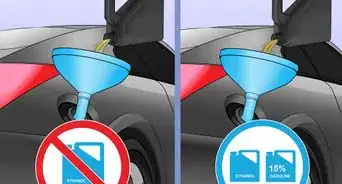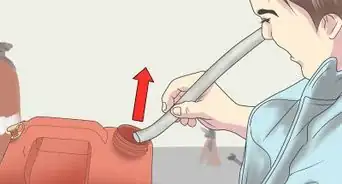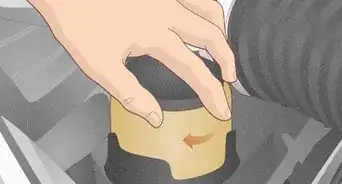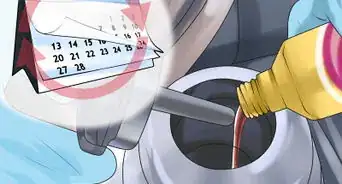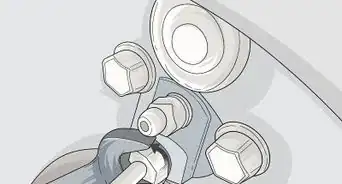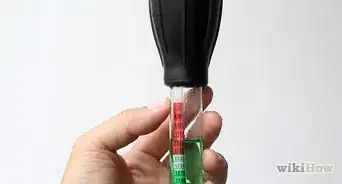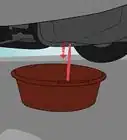wikiHow is a “wiki,” similar to Wikipedia, which means that many of our articles are co-written by multiple authors. To create this article, volunteer authors worked to edit and improve it over time.
This article has been viewed 245,890 times.
Learn more...
Due to the volatile nature of gas, certain procedures for handling and transporting gasoline should be utilized to ensure the safety of nearby people and buildings. Fire, combustion, and illness due to inhalation are a few of the potentially tragic consequences of gasoline. Anywhere there is gas, there is potential for danger, but you can reduce risk of tragedy by paying attention to potential hazards and taking precaution when filling gas cans.
Steps
How to Fill a Gas Can Safely
-
1Do not smoke anywhere near the gas pump or gas can.
-
2Turn off your vehicle's engine.Advertisement
-
3Make sure your container is made to hold gasoline. Approved gas cans are red and have a marking stating their intended use for gasoline.[1]
-
4Discharge static electricity. Static electricity can build up and cause a spark, igniting the gas fumes. Release any static electricity in your body collected from being in the car by touching a metal part of the car, possibly the car door, as you exit the vehicle.[2]
-
5Remove the gas can from your vehicle prior to filling it. Never fill a gas can that is located inside a vehicle or in the bed of a truck.[3] The can is not grounded from electrical charge if it is in a vehicle. Bed liners and mats in truck beds negate the grounding of static charges.
-
6Place the can on the ground at a safe distance from moving or parked vehicles and people.
-
7Touch the gas pump nozzle to the side of the can, never touch it first to rim of the gas can opening. If there is a spark, you don't want it at the opening where it could ignite fumes in the can.[4]
-
8Fill the can slowly to prevent splashing and overflow. Do not set the lock latch on the pump handle. Pay attention and pull the trigger manually.
-
9Do not fill the can all the way to the top. Leave a couple inches of space for fume expansion due to temperature changes.[5] This will also help thwart spills and overflow.
-
10Secure the cap tightly.
-
11Wipe off the outside of the can before you put it in your vehicle. If you do not have a cloth, look for one provided by the gas station at the window washing station.
How to Safely Transport Gas Cans
-
1Take steps to prevent gas spills in your vehicle. Make sure all caps and vent caps are on correctly and tightened. Sit the can upright. Secure gas cans so they can not move.
-
2Leave gas cans in your vehicle for as short a time as possible.[6] Make sure the area is not enclosed. Open windows to keep the space well ventilated. Do not leave gas cans in the trunk or inside the riding area of a vehicle.
-
3Keep gas cans away from sources of heat, even the sun, and spark.[7]
-
4Protect children and loved ones from the harmful fumes of gasoline. Gas cans should not be placed on the seat beside people. Secure the cans as far from people's faces as possible. Children should never be left in an enclosed vehicle with a gas can.
Community Q&A
-
QuestionIs safe to transport a filled gas can with no cap in the trunk of my car?
 Community AnswerNo, that is extremely dangerous for so many reasons.
Community AnswerNo, that is extremely dangerous for so many reasons. -
QuestionHow much gas can I transport legally?
 Community AnswerDue to fire safety laws in the U.S.A., you are only allowed to travel with a max of six gallons in a spare gas can.
Community AnswerDue to fire safety laws in the U.S.A., you are only allowed to travel with a max of six gallons in a spare gas can. -
QuestionDo I need to ask the gas station attendant if I can fill up a gas canister?
 Community AnswerNo. The process is just like filling up a car as far as the attendant is concerned. Just be sure to follow all of the safety steps above. Unless there is a sign posted, or some odd local law, there is no special process.
Community AnswerNo. The process is just like filling up a car as far as the attendant is concerned. Just be sure to follow all of the safety steps above. Unless there is a sign posted, or some odd local law, there is no special process.
References
- ↑ http://nasdonline.org/917/d000760/storing-gasoline-and-other-flammables.html
- ↑ https://www.goldeagle.com/tips-tools/tips-filling-gas-can/
- ↑ https://www.nps.gov/articles/fire-p52-gas-cans.htm
- ↑ https://www.cdc.gov/niosh/docs/98-111/pdfs/98-111.pdf?id=10.26616/NIOSHPUB98111
- ↑ https://www.nps.gov/articles/fire-p52-gas-cans.htm
- ↑ https://www.nps.gov/articles/fire-p52-gas-cans.htm
- ↑ https://www.familyhandyman.com/smart-homeowner/home-safety-tips/how-to-store-gasoline/
- https://www.dot.ny.gov/divisions/operating/employee-health-safety/transporting-gasoline-diesel
About This Article
If you need to fill and transport gasoline using a gas can, it's important that you follow a few safety precautions. Don’t smoke anywhere near the gas pump or can, and make sure to turn off the vehicle’s engine before pumping any gas. Put your gas can on the ground and fill it slowly to prevent splashing and overflowing. Leave a few inches of space at the top of the can for fumes expansion and to stop spills. When you’re done pumping, secure the lid and wipe off the outside of the can. Put the can upright in your car and secure it so it won’t spill or tip over. Remove the can from your car as soon as you can to prevent potentially harmful sparks or fumes. To learn how to know if a can is regulated to carry gas, keep reading!















